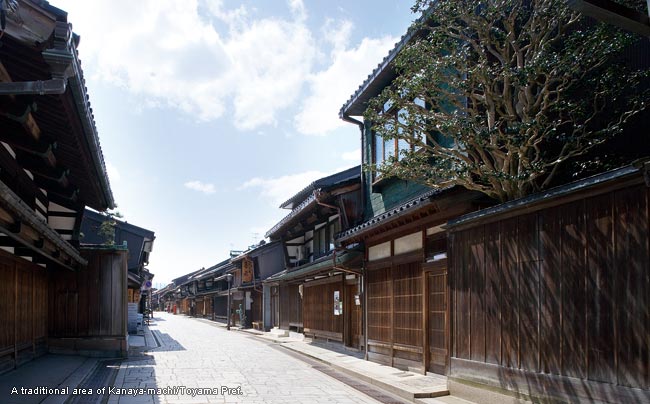
Hokuriku area boasts of many towns which have preserved their traditional cityscape and inherited their traditional industries to this date. These towns are not only famous for their 'retro' ambience but also for the traditional culture and industries which have helped the development of these towns over the years.
A town with world class copperware craftsmanship
Kanaya, an area located in Takaoka city is known as one of the biggest centers of copperware production, with a world class craftsmanship. Its history goes back about 400 years when the local feudal ruler invited 7 metal casters to settle in Kanaya-machi in 1609. These metal casting masters produced daily used articles such as pots, kettles as well as cast iron agricultural equipment such as spades and hoes; these artisans formed one of the biggest metal casters group of Japan.
The production of copperware articles began around the years 1751 – 1772. With the start of the copper production of Buddhist objects such as hanging bells or Buddha statues, the production of copper and iron objects flourished as well. In the second half of the 19th century, the copper objects produced in this region were also displayed at overseas exhibitions and became globally recognized as the "Takaoka Copperwares". Today, the copperwares produced in Takaoka account for 90% of Japan's total copperware production.
Kanaya-machi developed as a town of artisans and the town still preserves its traditional look. One can enjoy the view of senbon-koshi (thousand lattices) also called "Sama-no-ko"and cobblestone pathways, some of which stretch to almost 500 m. Some of these cobblestone pathways have chips of copper buried into them which is also a unique feature of Kanaya-machi. You can visit different shops while enjoying the town streets that makes you reminisce about the old times.
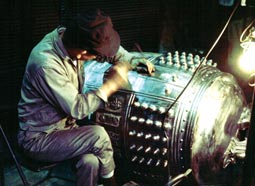
Takaoka copperware craftsman in action
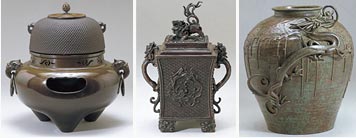
Takaoka Copperware Work
A port town area with old merchant houses & storehouses where the fragrance of ocean meets the fragrance of soy sauce.
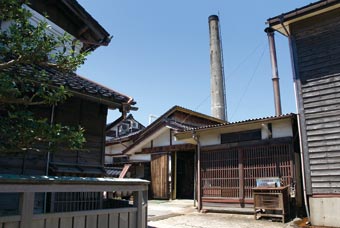
A traditional area of Ono/Ishikawa Pref.
Ono is famous as Kanazawa city's soy sauce manufacturing center. The main feature of Ono Shoyu (soy sauce) is 'uma-kuchi'or the enhanced flavour. In spite of its sweetness, this shoyu variety has a distinct flavour as it makes good use of the natural taste of ingredients. This shoyu has supported Kanazawa's rich culture from behind the scenes and has contributed significantly to the development of Kaga Cuisine.
The history of Kanazawa's soy sauce manufacturing dates back 400 years; it is believed that Naoeya Ihei, a merchant from Ono was ordered by the then feudal lord to make shoyu and as a result, he learnt the soy sauce manufacturing techniques in regions famous for their shoyu production and then came back to Kanazawa.
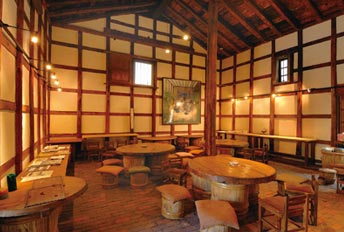
An old shoyu storehouse was redecorated and turned into an elegant gallery-cum-cafe
The port side old merchant houses with their traditional ki-musuko-gumi (same as senbon-koshi lattice) have preserved their traditional architecture in spite of some restoration work and can be still seen in Ono. Shoyu soft ice cream, as the name suggests, is a popular ice cream mixed with soy sauce which tastes like caramel.
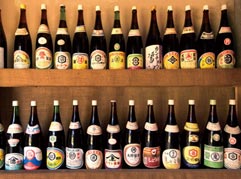
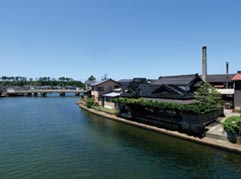
Ono Shoyu (left). Ono area, situated right next to the seaside (right)
People in Ono have managed to pass down their traditions by keeping pace with the changing times, while preserving the original taste and style. You can appreciate a retro atmosphere at this small port side area while enjoying a mixed fragrance of shoyu and the sea.
Japan's No. 1 Paper,"Echizen-Washi" & The Town That Made It Possible
Fukui's traditional culture is evident in the old city of Echizen, famous for Echizen-Washi (traditional Japanese paper) which is known as one of the 3 most famous washi papers along with the washi papers from Mino and Tosa; Former Imadate-cho (present Echizen City) has been the main production center for Echizen-Washi.
The legend has it that about 1500 years ago, a beautiful woman appeared near the upstream waters of Okamoto River in Imadate town and taught the village people the craft of paper making. In ancient times, the paper produced in Imadate was famous as "Japan's No. 1 Paper" and was used to make paper money; even in modern times it has found strong supporters among many artists and today, the Echizen-Washi continues to be loved by the people who appreciate the first-class quality.
The traditional paper making craft has been passed down to the present day and the production volumes as well as the wide variety of handmade washi paper continue to be Japan's number 1. Echizen, thus, continues to be "Land of Washi" as it has been for centuries.
One of the local attractions is an area known as "Goka-chiku". Goka-chiku has retained its old world charm as a number of houses built by the manufacturers of high-quality handmade washi paper continue to stand proudly even today. What's more, some of these houses still function as workshops for handmade washi. In 2006, Goka-chiku was also selected as one of the "Beautiful Japan's 100 Historical Landscapes" as it was recognized as an "area that has preserved Japan's beautiful historical landscape that should be passed down to the future generations".
Located close to Goka-chiku is the Echizen Washi-no-Sato Craft Village where you can feel the soul of Echizen-washi by trying your hands on making washi or by visiting the museum which introduces the history of Echizen-washi. You can also buy a variety of washi products or washi paper itself.
Every Spring and Autumn, a festival called "Kami & Kami Festival"(in Japanese 'kami'can mean either god or paper) is held in Washi-no-Sato. This "God & paper Festival has been designated as Intangible Cultural Asset. A number of events are held at the festival including performances of traditional arts such as paper-Noh and paper-kagura theatre.
Visiting and experiencing Hokuriku's unique living traditional culture
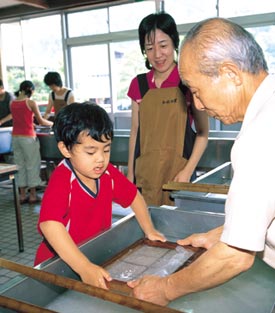
You can have a hands-on experience of washi making at Washi-no-Sato
It was possible to pass down various traditional skills through generations since the regions where these skills originated were protected by powerful feudal lords; however, what made it possible to preserve these traditions, survive as an industry and conserve the old town, was not just the political protection but a firm technological strength and "Hokuriku Spirit". All these factors make Hokuriku a special place and help Hokuriku towns to escape total urbanization and preserve its traditional culture. The historical and cultural heritage of Hokuriku is not limited to these 3 towns but extends to many more areas.
So how about visiting these towns and experiencing Hokuriku's unique living traditional culture!

Traditional Japanese paper 'washi' continues to be popular even today.
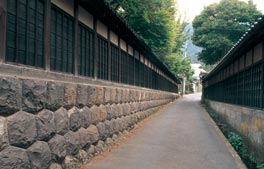
A beautiful traditional area of Imadate town

